قائمة مواقع التراث العالمي في جورجيا
The United Nations Educational, Scientific and Cultural Organization (UNESCO) designates World Heritage Sites of outstanding universal value to cultural or natural heritage which have been nominated by countries which are signatories to the UNESCO World Heritage Convention, established in 1972.[1] Cultural heritage consists of monuments (such as architectural works, monumental sculptures, or inscriptions), groups of buildings, and sites (including archaeological sites). Natural features (consisting of physical and biological formations), geological and physiographical formations (including habitats of threatened species of animals and plants), and natural sites which are important from the point of view of science, conservation or natural beauty, are defined as natural heritage.[2] Georgia ratified the convention on 4 November 1992.[3]
اعتبارا من 2020[تحديث], Georgia has four sites on the list and a further fourteen on the tentative list. The first two sites inscribed to the list were the Historical Monuments of Mtskheta and the site comprising Bagrati Cathedral and Gelati Monastery, in 1994. However, due to major reconstruction detrimental to its integrity and authenticity, Bagrati Cathedral was put to the List of World Heritage in Danger in 2010 and then delisted as a World Heritage Site in 2017. Upper Svaneti was listed in 1996 and the most recent site listed was the Colchic Rainforests and Wetlands, in 2021. The latter is the only natural site of Georgia, the other three are of the cultural type.[3]
. . . . . . . . . . . . . . . . . . . . . . . . . . . . . . . . . . . . . . . . . . . . . . . . . . . . . . . . . . . . . . . . . . . . . . . . . . . . . . . . . . . . . . . . . . . . . . . . . . . . . . . . . . . . . . . . . . . . . . . . . . . . . . . . . . . . . . . . . . . . . . . . . . . . . . . . . . . . . . . . . . . . . . . .
World Heritage Sites
UNESCO lists sites under ten criteria; each entry must meet at least one of the criteria. Criteria i through vi are cultural, and vii through x are natural.[4]
| Site | Image | Location | Year listed | UNESCO data | Description |
|---|---|---|---|---|---|
| Historical Monuments of Mtskheta | 
|
Mtskheta-Mtianeti | 1994 | 708; iii, iv (cultural) | Mtskheta was the capital of Georgia from the 3rd century BCE to the 5th century CE, and is still the centre of the Georgian Orthodox Church. It was the place where Christianity was proclaimed as the official religion of Georgia in 337. The Jvari Monastery (pictured) dates to the 6th century while the Svetitskhoveli Cathedral and the Samtavro Monastery were built in the 11th century upon the site of earlier churches. The monuments represent different stages in the development of medieval religious architecture in the region.[5] |
| Gelati Monastery | 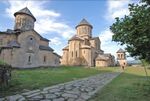
|
Imereti | 1994 | 710; iv (cultural) | Gelati Monastery, a masterpiece of the Georgian Golden Age, was built in 1106 by King David IV and was one of the main cultural and intellectual centres in Georgia throughout the Middle Ages. It had an Academy which employed some of the most celebrated Georgian scientists, theologians, and philosophers, many of whom had previously been active at various orthodox monasteries abroad, such as from the Mangan Academy in Constantinople. At the time of inscription, the World Heritage Site also included the Bagrati Cathedral. Between 2010 and 2017, it was listed as endangered due to the cathedral undergoing major reconstruction detrimental to its integrity and authenticity. In 2017, Bagrati Cathedral was removed from the World Heritage property and Gelati Monastery was delisted from the endangered list.[6][7] |
| Upper Svaneti | 
|
Samegrelo-Zemo Svaneti | 1996 | 709; iv, v (cultural) | Upper Svaneti is a valley along the Enguri river between the Caucasus and the Svaneti Range. The Svan communities adapted to the life in mountain regions. The most prominent architectural feature of the villages are the medieval stone towers which had both defensive and residential functions. More than 200 towers and houses have been preserved in the village of Chazhashi.[8] |
| Colchic Rainforests and Wetlands | 
|
Samegrelo-Zemo Svaneti, Guria, Adjara | 2021 | 1616; ix, x (natural) | The coastal region of Georgia (the historical Colchis) is covered by wetlands, forests, peat bogs, lakes, and sandy dunes. Some areas are protected as Ramsar sites. They are important biodiversity spots and serve as a stop on the migration routes of birds such as the black stork, common crane, and great egret. The World Heritage Site comprises seven properties: Kintrishi-Mtirala and Ispani in Adjara, Grigoleti and Imnati in Guria, and Pitshora, Nabada, and Churia in Samegrelo-Zemo Svaneti. They are administered in Georgia as parts of the Kolkheti National Park (pictured), Kintrishi Strict Nature Reserve, Kobuleti Protected Areas, and Mtirala National Park.[9][10] |
Tentative list
In addition to sites inscribed on the World Heritage List, member states can maintain a list of tentative sites that they may consider for nomination. Nominations for the World Heritage List are only accepted if the site was previously listed on the tentative list.[11] اعتبارا من 2020[تحديث], Georgia maintains fourteen properties on its tentative list.[3]
| Site | Image | Location | Year listed | UNESCO criteria | Description |
|---|---|---|---|---|---|
| Alaverdi Cathedral | 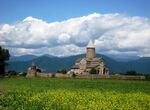
|
Kakheti | 2007 | iv, vi (cultural) | The cathedral was built in the first half of the 11th century on the site of a monastery dating to the 6th century. With a height of 50 metres (160 ft), it is the tallest cathedral in Georgia, and has a very spacious interior. The complex is surrounded by a fortified wall.[12] |
| Ananuri | 
|
Mtskheta-Mtianeti | 2007 | iii (cultural) | The Ananuri castle complex, built in the 17th century, is located along the Georgian Military Road. It comprises several churches with fine wall paintings and wall reliefs. The Church of the Virgin is the burial place of the eristavis (Dukes) of Aragvi.[13] |
| David Gareji Monasteries and Hermitage | 
|
Kakheti | 2007 | i, ii, iii, iv, v, vi, vii, x (mixed) | The Georgian Orthodox monastery complex comprises 19 medieval monasteries with about 5000 cells for monks. The first monasteries were founded in the 6th century by St. David Garejeli, one of the Thirteen Assyrian Fathers who came to Georgia. The monasteries saw a golden age between the 10th and the 13th centuries, declined following the Mongol invasions, and saw a revival on a smaller scale in the 17th and 18th centuries. Murals from different periods have been preserved in churches. Remains from Bronze and Iron Age settlements have been found in the area as well.[14] |
| Dmanisi Hominid Archaeological Site | 
|
Kvemo Kartli | 2007 | iii, v (cultural) | The hominid remains found at Dmanisi belong to some of the earliest hominid fossils outside Africa. The excavations have been ongoing since 1983. Several skulls, teeth, post-cranial remains, as well as stone artefacts and animal remains have been found at the site. They were dated to 1.75 million years ago and represent an important stage in human evolution.[15] |
| Gremi Church of Archangels and Royal Tower | 
|
Kakheti | 2007 | ii, iii (cultural) | Gremi, a city on the Silk Road, was the capital of the Kingdom of Kakheti until it was destroyed by the Safavid Shah Abbas in the 17th century and left in ruins. The Church of the Archangels was commissioned in 1565 by King Levan and represents an evolution of Georgian ecclesiastic architecture. A three-storey tower with a belfry on top is located next to the church.[16] |
| Kvetera Church | 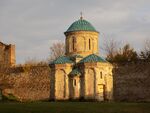
|
Kakheti | 2007 | iii, iv (cultural) | Kvetera Church was built in the 10th century within a fortress complex. Architecturally, it is a derivative of the Jvari Church in Mtskheta. It is a small church with a plan that is a four-apse cross with four niches between apses.[17] |
| Mta-Tusheti | 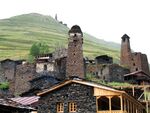
|
Kakheti | 2007 | iv, v, vii, x (mixed) | Mta-Tusheti is a region on the slopes of the Caucasus mountains. The habitats up the slopes of the mountains change from forests to high meadows to the subnivean zone, and each is home to a variety of animals and plants. The vernacular architecture of the region is characterized by fortress-like buildings, similar to those in Svaneti.[18] |
| Nikortsminda Cathedral | 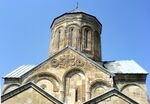
|
Racha | 2007 | ii, iv (cultural) | The Nikortsminda Cathedral, one of the most important medieval monuments in Georgia, was constructed in the early 11th century during the reign of King Bagrat III. The church has a hexagonal plan and is decorated with reliefs depicting religious themes. The interior is decorated with paintings from the 16th and 17th centuries.[19] |
| Samtavisi Cathedral | 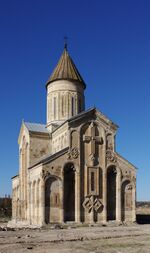
|
Shida Kartli | 2007 | iv (cultural) | The Samtavisi Cathedral was built in 1030 and saw a major renovation in the 15th century, including rebuilding the dome and the western wall. In view of the architectural development, the cathedral introduced a new style of decoration, with a large ornamental cross on the eastern facade and a lozenge pattern. Fragments of the 17th century frescos remain in the interior.[20] |
| Shatili | 
|
Mtskheta-Mtianeti | 2007 | v (cultural) | Shatili is a mountain village at an elevation of 1,400 metres (4,600 ft), located in the Argun River gorge. The village is a fortress complex, with buildings serving both in residential and defence functions. The village dates to the late medieval and early modern period.[21] |
| Tbilisi Historic District | 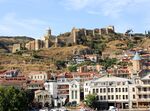
|
Tbilisi | 2007 | ii, iii, iv, v, vi (cultural) | Tbilisi, the capital of Georgia, was an important city on the Silk Road and a major centre in the Caucasus region. It was founded in the 5th century CE and was marked by influences of different cultures. The city is located on the banks of the Mtkvari River and is overlooked by the Narikala Fortress. Typical features of Tbilisi are balconies and courtyards of residential houses.[22] |
| Uplistsikhe Cave Town | 
|
Shida Kartli | 2007 | ii, iii, iv, v (cultural) | First traces of human occupation at Uplistsikhe date to the 2nd millennium BCE. It was an important centre during the Hellenistic period and late antiquity, reached another heyday from the 9th to 11th centuries, and was ultimately ravaged during the Mongol raids in the 13th century. The town is cut in rock, including a palace complex and a three-nave basilica from the 6th century. Some caves have complex decorations.[23] |
| Vani | 
|
Imereti | 2007 | ii, iii, vi (cultural) | Vani was an ancient city in the historic region of Colchis that was inhabited from the 7th to the 1st century BCE. It was a political and religious centre of the area. In the Hellenistic period, the city saw a significant influence of Greek culture, in view of architecture, jewellery, and burial customs. The archaeological excavations uncovered a large number of artefacts that are now on display at the Georgian National Museum in Tbilisi.[24] |
| Vardzia-Khertvisi | 
|
Samtskhe–Javakheti | 2007 | ii, iii, iv, v, vi, vii (mixed) | This nomination comprises the gorge of the Mtkvari River in the length of 18 kilometres (11 mi) between the Khertvisi Fortress and the rock monastery in Vardzia that was constructed in the 12th and 13th centuries. Human settlements have been adapted to the layout of the landscape.[25] |
. . . . . . . . . . . . . . . . . . . . . . . . . . . . . . . . . . . . . . . . . . . . . . . . . . . . . . . . . . . . . . . . . . . . . . . . . . . . . . . . . . . . . . . . . . . . . . . . . . . . . . . . . . . . . . . . . . . . . . . . . . . . . . . . . . . . . . . . . . . . . . . . . . . . . . . . . . . . . . . . . . . . . . . .
See also
References
- ^ "The World Heritage Convention". UNESCO World Heritage Centre. Archived from the original on 27 August 2016. Retrieved 21 September 2010.
- ^ "Convention Concerning the Protection of the World Cultural and Natural Heritage". UNESCO World Heritage Centre. Archived from the original on 1 February 2021. Retrieved 3 February 2021.
- ^ أ ب ت "Georgia". UNESCO World Heritage Centre. Archived from the original on 8 March 2021. Retrieved 26 March 2021.
- ^ "UNESCO World Heritage Centre – The Criteria for Selection". UNESCO World Heritage Centre. Archived from the original on 12 يونيو 2016. Retrieved 17 أغسطس 2018.
- ^ "Historical Monuments of Mtskheta". UNESCO World Heritage Centre. Archived from the original on 8 December 2005. Retrieved 26 March 2021.
- ^ "Gelati Monastery, Georgia, removed from UNESCO's List of World Heritage in Danger". UNESCO World Heritage Centre. Archived from the original on 15 July 2017. Retrieved 23 April 2018.
- ^ "Gelati Monastery". UNESCO World Heritage Centre. Archived from the original on 3 August 2005. Retrieved 26 March 2021.
- ^ "Upper Svaneti". UNESCO World Heritage Centre. Archived from the original on 23 March 2021. Retrieved 26 March 2021.
- ^ "Colchis Wetlands and Forests". UNESCO World Heritage Centre. Archived from the original on 26 July 2021. Retrieved 5 August 2021.
- ^ "Georgia's Colchic Rainforests, Wetlands Granted World Heritage Status". Civil Georgia. 27 July 2021. Archived from the original on 28 July 2021. Retrieved 31 July 2021.
- ^ "Tentative Lists". UNESCO World Heritage Centre. Archived from the original on 1 April 2016. Retrieved 7 October 2010.
- ^ "Alaverdi Cathedral". UNESCO World Heritage Centre. Archived from the original on 10 July 2019. Retrieved 3 April 2021.
- ^ "Ananuri". UNESCO World Heritage Centre. Archived from the original on 15 August 2020. Retrieved 3 April 2021.
- ^ "David Gareji Monasteries and Hermitage". UNESCO World Heritage Centre. Archived from the original on 11 November 2020. Retrieved 3 April 2021.
- ^ "Dmanisi Hominid Archaeological Site". UNESCO World Heritage Centre. Archived from the original on 3 August 2019. Retrieved 3 April 2021.
- ^ "Gremi Church of Archangels and Royal Tower". UNESCO World Heritage Centre. Archived from the original on 7 August 2020. Retrieved 3 April 2021.
- ^ "Kvetera Church". UNESCO World Heritage Centre. Archived from the original on 5 August 2020. Retrieved 3 April 2021.
- ^ "Mta-Tusheti". UNESCO World Heritage Centre. Archived from the original on 30 October 2020. Retrieved 6 April 2021.
- ^ "Nicortsminda Cathedral". UNESCO World Heritage Centre. Archived from the original on 11 August 2020. Retrieved 6 April 2021.
- ^ "Samtavisi Cathedral". UNESCO World Heritage Centre. Archived from the original on 23 June 2020. Retrieved 6 April 2021.
- ^ "Shatili". UNESCO World Heritage Centre. Archived from the original on 28 January 2021. Retrieved 6 April 2021.
- ^ "Tbilisi Historic District". UNESCO World Heritage Centre. Archived from the original on 24 September 2020. Retrieved 6 April 2021.
- ^ "Uplistsikhe Cave Town". UNESCO World Heritage Centre. Archived from the original on 26 April 2021. Retrieved 6 April 2021.
- ^ "Vani". UNESCO World Heritage Centre. Archived from the original on 13 April 2021. Retrieved 6 April 2021.
- ^ "Vardzia-Khertvisi". UNESCO World Heritage Centre. Archived from the original on 13 April 2021. Retrieved 6 April 2021.
External links
 Media related to World Heritage Sites in Georgia at Wikimedia Commons
Media related to World Heritage Sites in Georgia at Wikimedia Commons


